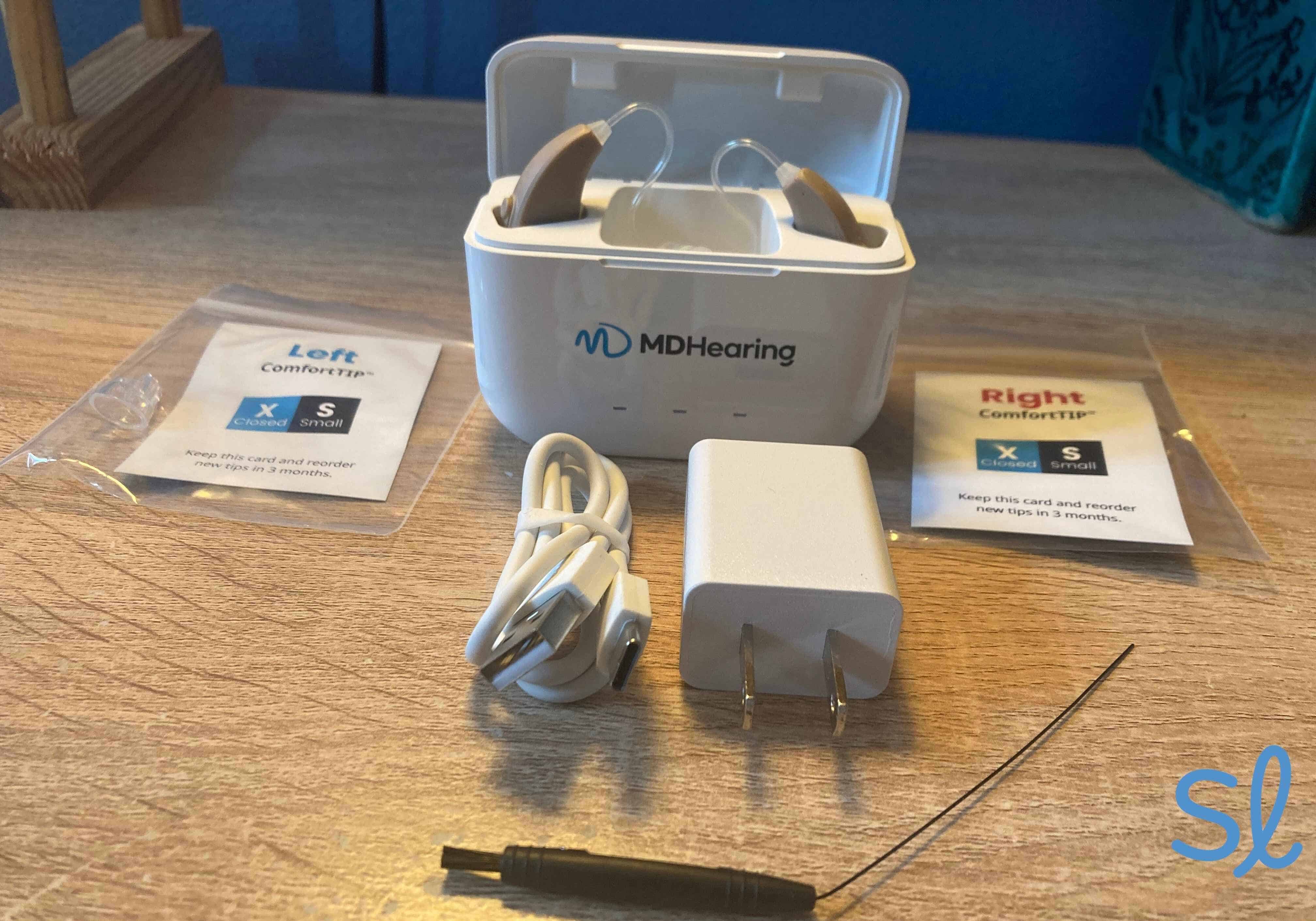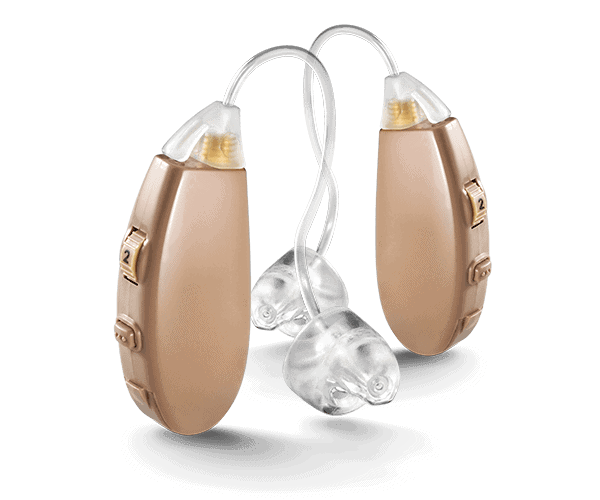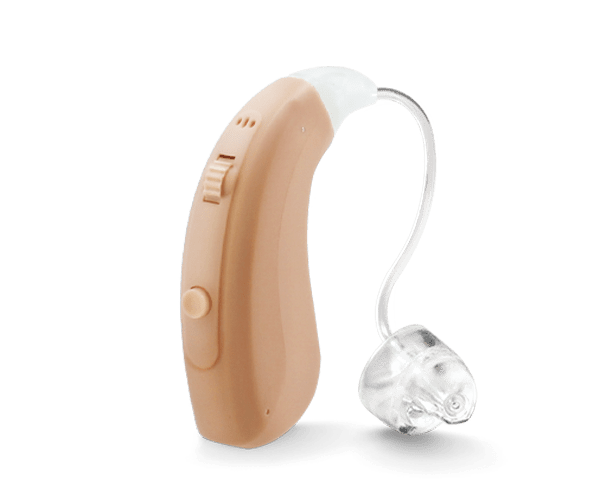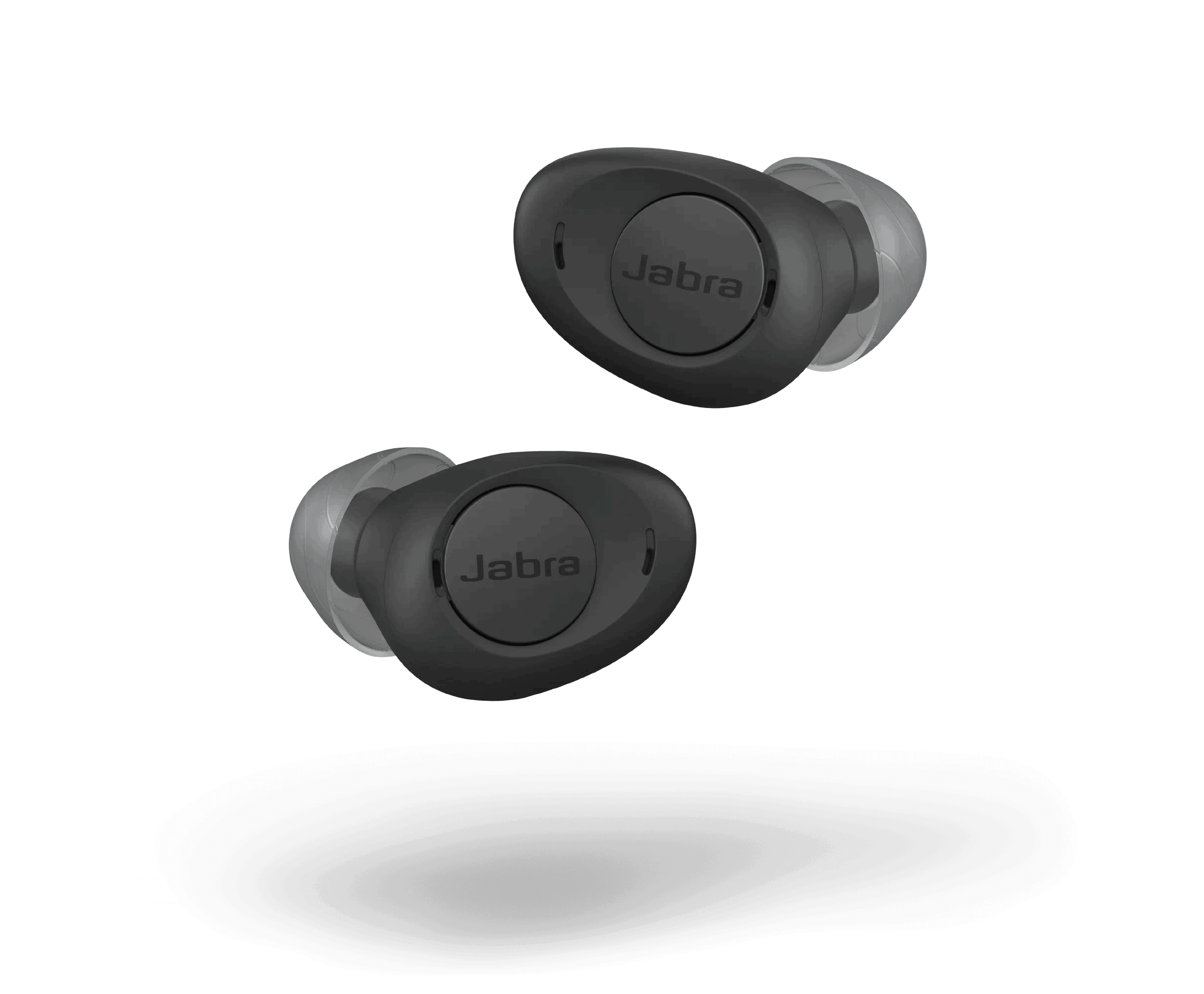MDHearing Reviews in 2025
MDHearing offers some of our favorite behind-the-ear and completely-in-the-canal OTC hearing aids for mild to moderate hearing loss.
How We Tested MDHearing
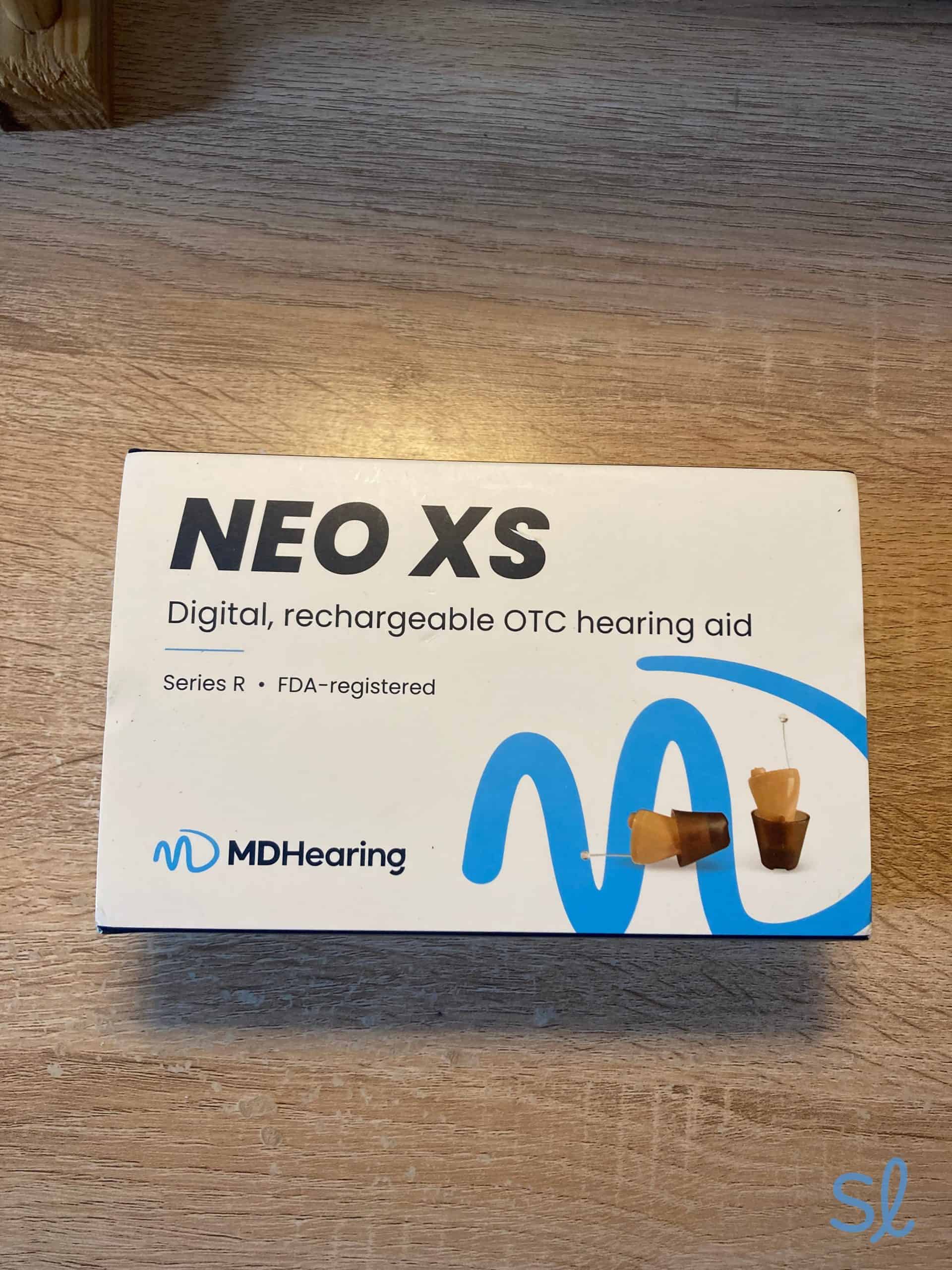
We unboxed and tested MDHearing’s devices, including the NEO XS, to determine their price and value.
MDHearing has been on our radar for a long time. Since they improve their technology and add new models to their roster of styles every year or so, I spoke to their audiologists and customer service representatives repeatedly to find out what’s new and what’s been discontinued. Then, I ordered their current offerings to try at home.
When the hearing aids arrived, I unboxed, set up, charged, and wore them in multiple sound settings, including a park, city street, and home. I listened to music, watched television, and had several conversations in person and via phone.
I assessed each pair for comfort, fit, and visibility. I spent a week wearing them to provide accurate information about their noise and feedback reduction capabilities, ease of programming, and overall sound quality.
Here’s what the testing process consisted of:
- I researched MDHearing aids online and through conversations with their audiological staff members.
- Then, I ordered VOLT MAX 2 and NEO XS PRO to try out at home.
- Once I received the hearing aids, I unboxed and reviewed all of the printed materials that came with them.
- I charged the hearing aids and timed the process.
- I tried on and wore the hearing aids to assess their comfort, sound quality, and programming ease. I also made note of how long they held a charge.
- I downloaded the MDHearing app and used it to program both sets of hearing aids.
- I used the cleaning tools that came with them to check their effectiveness.
- I returned one defective hearing aid and went through the exchange process with MDHearing successfully.
Based on this hands-on experience, I evaluated the hearing aids for the following criteria.
- Price and value: MDHearing is a very budget-friendly option for seniors with mild to moderate hearing loss. They’re more affordable than most of the other hearing aids I’ve tested. I considered up-front costs, any extra fees, and seasonal promotions.
- Battery life: These hearing aids hold a charge for 16 to 20 hours, based on style. Since they’re rechargeable, they’re a good choice for individuals who don’t want to replace disposable batteries consistently.
- Sound quality: MDHearing’s devices offer decent sound quality. NEO XS PRO is a standout in MDHearing’s lineup for providing crisp, clear sound.
- Special features: MDHearing doesn’t offer Bluetooth streaming. If you’re looking for “bells and whistles,” you will probably be better off with a different hearing aid brand, like Signia.
MDHearing is a leader in affordable over-the-counter hearing aids. Their offerings are budget-friendly and give those with mild to moderate hearing loss the option to purchase hearing aids without visiting an audiologist in person. MDHearing’s hearing aids consistently make our list of the best over-the-counter hearing aids.
For this review, I took MDHearing’s online hearing test (my results are below) and tried two of the brand’s most recent offerings. I tested out the NEO XS PRO, MDHearing’s smallest and most technologically advanced hearing aid, plus the VOLT MAX 2, a simple behind-the-ear model.
My main takeaway for seniors is that MDHearing’s prices and features can provide improvement for people who are new to hearing aids, and for those with mild to moderate hearing loss. Read on as I provide the nitty-gritty details of my testing experience and show you why MDHearing made our list of the best hearing aids in 2025!
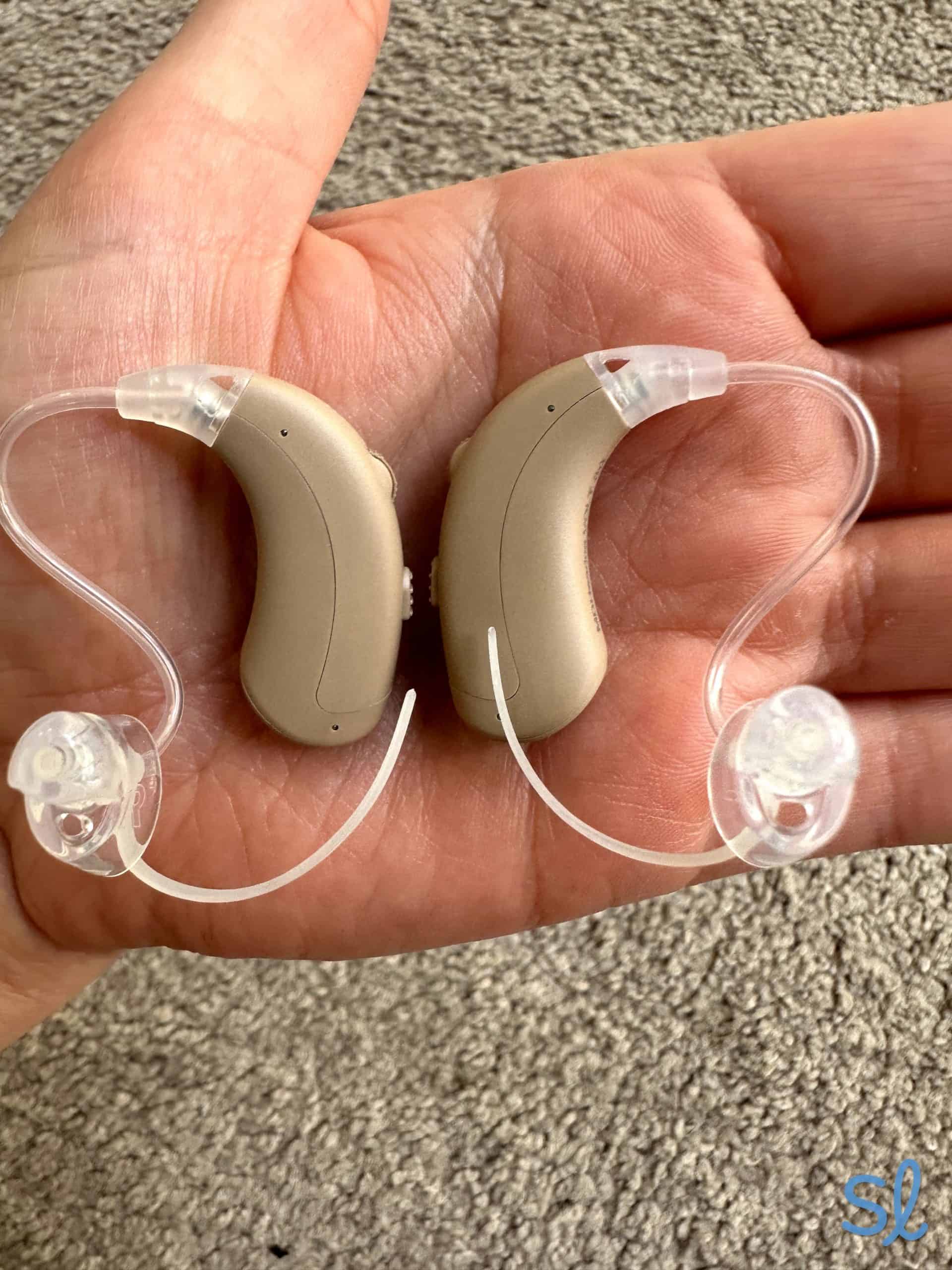
Testing out MDHearing's VOLT devices

Taking MDHearing’s Online Hearing Test
MDHearing’s online hearing test is easy to use, comprehensive, and accurate. The results I received were the same as those I got after taking a traditional, audiologist-administered sound booth test.

MDHearing’s test is simple to use and easy to navigate. Of all the online tests I’ve tried, it’s at the top. I appreciated that they displayed my results in both a simplified thermometer version and a traditional audiogram format. I enjoyed how the interface and results provide information that caters to the needs and level of understanding of both first-time and more experienced users.
If you’re planning on taking this or any online hearing test, make sure to wear higher-quality headphones while you’re taking the test. Subpar or very old models may require higher volume levels. It can skew your results and make your hearing seem worse than it is.
Quick Tip: If you’re new to the world of hearing aids and hearing tests, visit our hearing aid buyer’s guide. We’ll walk you through everything you need to know before purchasing hearing aids for the first time.
The top image illustrates how the test is conducted. You are first asked to put on headphones and set your volume to “max.” (This means the highest volume possible on the headphones or device you’re using.) You’ll then select the softest tone you can hear at six different frequencies, one ear at a time.
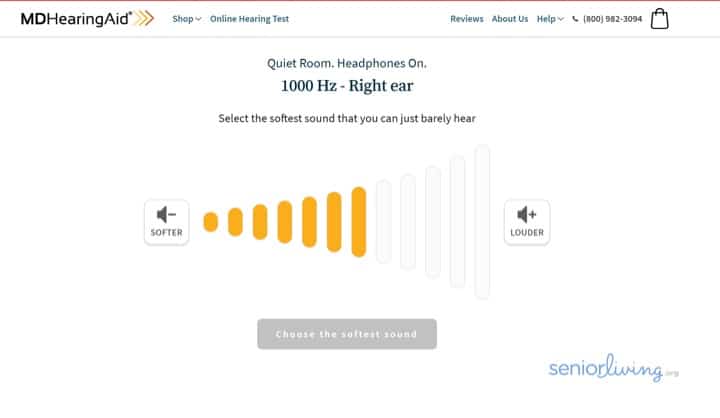
MDHearing Online Hearing Test — Right ear test
The thermometer image from my test below shows that my responses were comparable to those of individuals without hearing loss. “Normal” hearing is a range, but I'm in good shape because my scores are in the lower half of the green section.
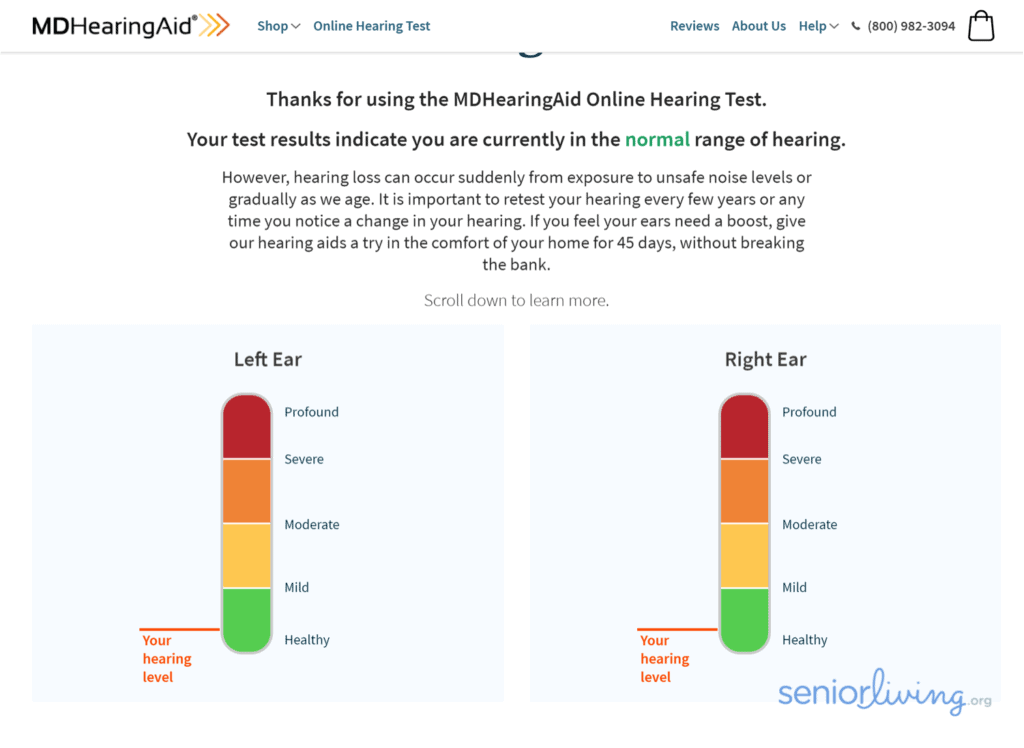
MDHearing Online Hearing Test — Hearing level results
It is also shown in the traditional audiogram image below. In this case, the good scores (in green) are towards the top. The red Os are for my right ear, and the blue Xs are for my left ear. Each mark represents the softest level in decibels (dB) at which I heard each tone. The lower bass tones are on the left, and the higher treble pitches are on the right, like a piano.
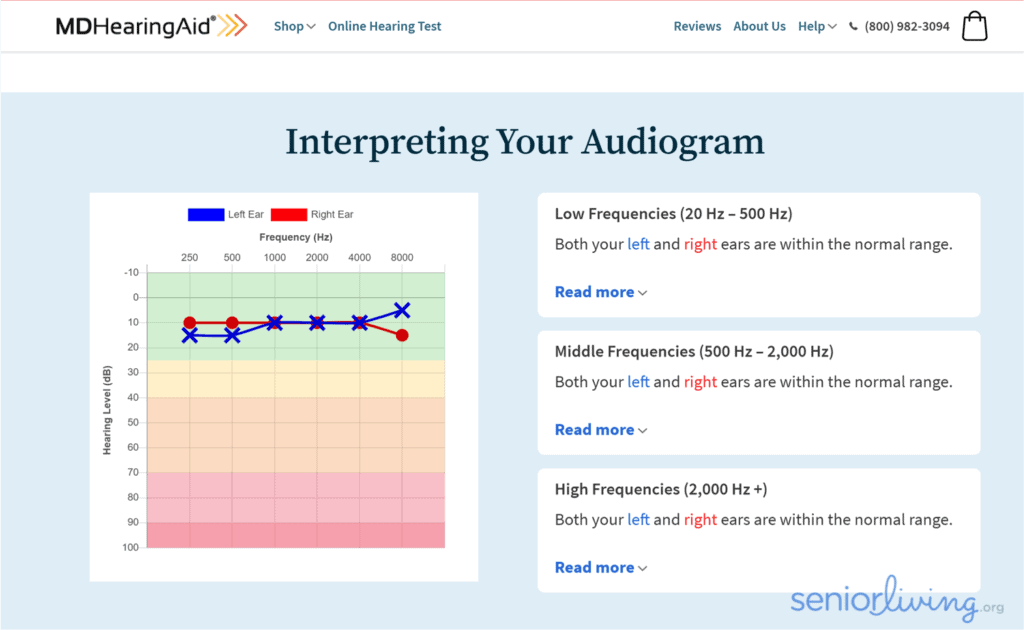
MDHearing – Interpreting Your Audiogram
MDHearing offers a variety of budget-friendly OTC hearing aids and 24/7 lifetime support.

Comparing MDHearing Devices
| VOLT | VOLT MAX 2 | NEO XS PRO | NEO | NEO XS | AIR | |
|---|---|---|---|---|---|---|
| Price per pair | $397 | $597 | $597 | $297 | $397 | $297 |
| Style | BTE (behind-the-ear) | BTE | ITE (in-the-ear) | ITE | ITE | BTE |
| Noise reduction and feedback cancellation | Advanced | Advanced | Improved | Standard | Improved | Standard |
| Number of sound environments | 4 | 4 | 4 | 1 | 4 | 4 |
Testing MDHearing Devices
Unboxing My NEO XS PRO Hearing Aids
The sturdy box containing the NEO XS PRO hearing aids arrived intact, with instructions about the company’s return policy on large, separately packed pages. I was glad to see that MDHearing guarantees customer satisfaction with a full 45 days to return the hearing aids if they don’t work out. There was no fine print I might overlook.
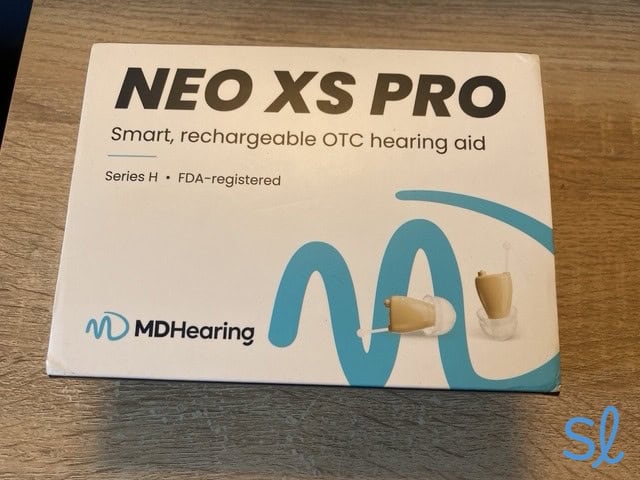
My NEO XS PRO box from MDHearing
The outer box sleeve slipped off easily, with no needfor scissors — a huge plus if you have stiff or arthritic fingers. The first thing I saw upon opening the box was a pamphlet that said, “Read me first,” so I did.
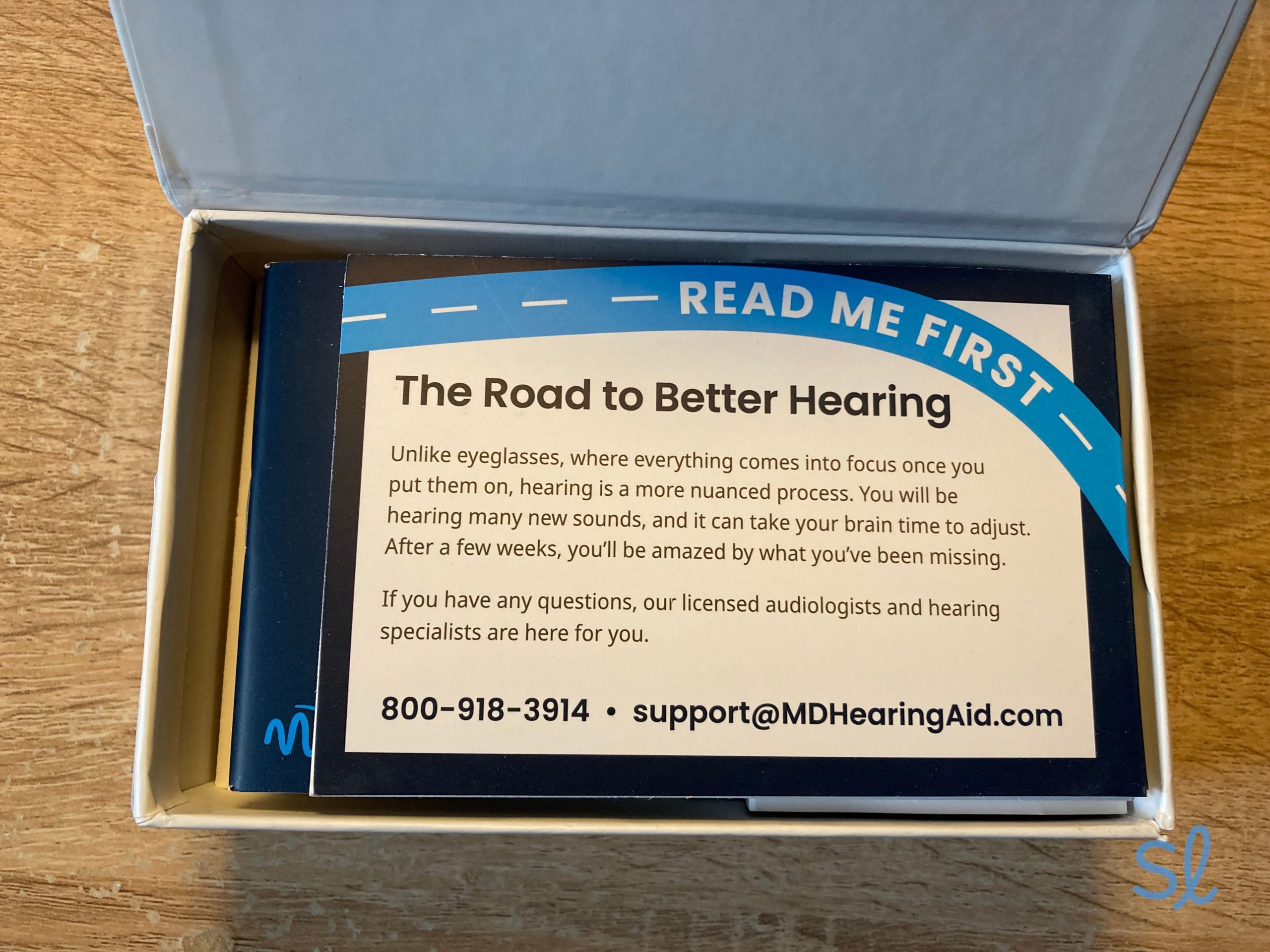
Reading MDHearing's instructions for my NEO XS PRO devices
The pamphlet clearly outlined what I could expect over the next three weeks as I got used to my new hearing aids. It provided tips on adjusting to them, such as listening to familiar music, going to the movies, or hanging out with friends. It dawned on me while reading the tips that my hearing aids could help reduce the isolation that often accompanies hearing loss.
Did You Know? Studies indicate that older adults with hearing loss often feel frustrated or embarrassed by their disability during conversations. This typically leads to withdrawal from social situations, as well as social isolation, loneliness, and depression.1
Under the pamphlet was the compact, 50-page user manual. I tend not to have patience for these things, but the manual was written with ease of use in mind – but it was only in English. I called MDHearing to see if it’s available in other languages, like Spanish, and it is! To receive the manual and other materials in languages other than English, call customer service. If you need help and the language you speak isn’t available, you can use the automatic translation feature in the chat on the company’s website. Hearing loss can be challenging enough without any language barriers. I’m glad MDHearing is working toward removing that obstacle.
The user manual included a diagram of the hearing aids and a Quick Start section. It also had a package contents page, so I used that to ensure I had everything I was supposed to. In addition to the printed materials, here’s what was in the box:
- Charging case
- Charging cord
- Hearing aids
- Five domes (two large, two small, and one medium)
- Cleaning and wax guard tools
- Read Me First manual
- App manual
- User manual
- Stand-alone instruction cards on cleaning, charging, replacing parts monthly, and contacting the company
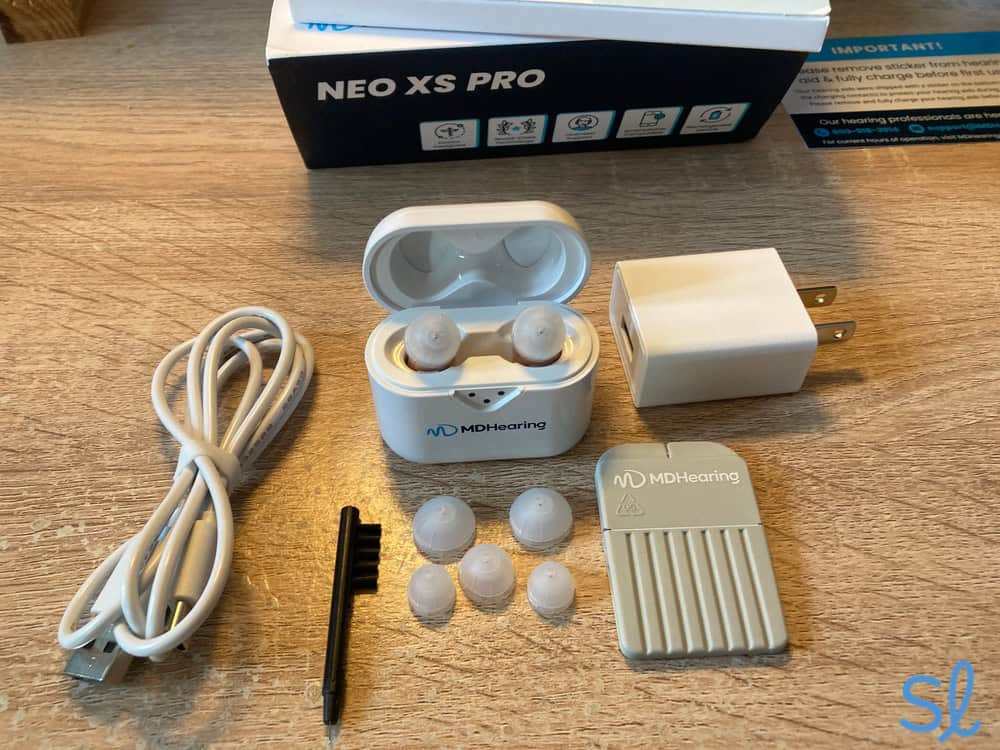
Everything included in my NEO XS PRO package from MDHearing
Charging My Hearing Aids
After reading the materials, the next step was to charge the hearing aids. I plugged the charging case, which contained the hearing aids, into a standard outlet using the USB cord. Three little blue lights came on, indicating it was charging.
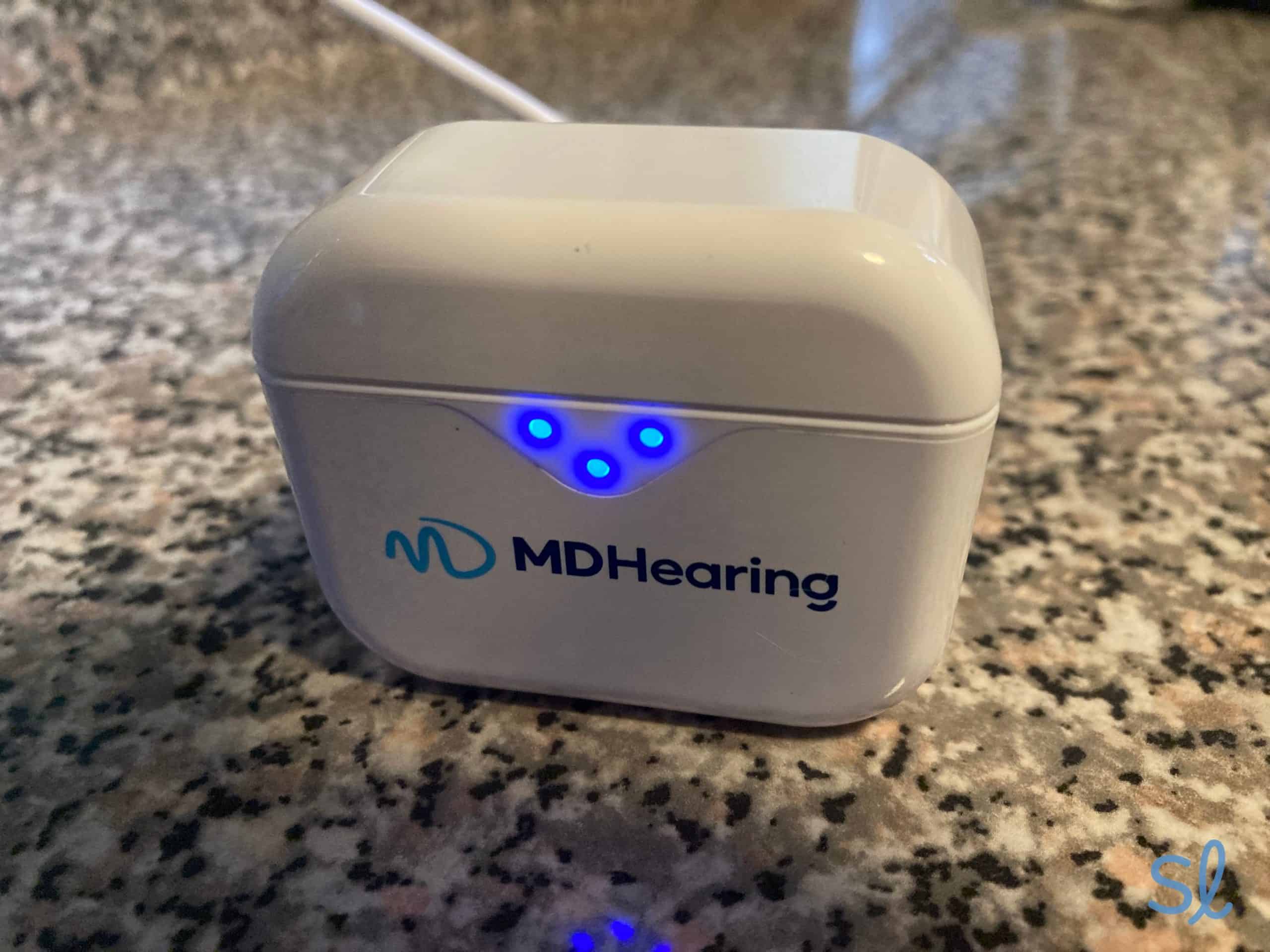
Charging my NEO XS PRO devices from MDHearing
One of the lights turned green fairly quickly. That confused me at first, since I thought all the lights would turn green simultaneously to indicate a full charge. I checked the manual and found out that I needed to wait until all three lights were green.
Eventually, all three lights turned green, indicating that the hearing aids were fully charged in about two hours. I was impressed with the speed of the charge, especially compared to the Eargo hearing aids, which took six hours to fully charge during testing.
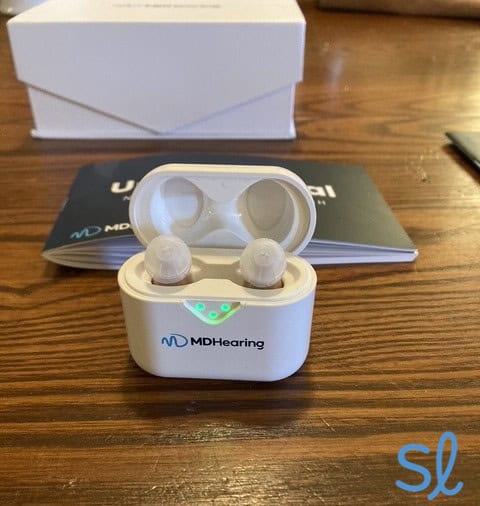
Green lights indicating that my NEO XS PRO MDHearing devices were fully charged
Fitting and Using the NEO XS PRO Devices
These hearing aids may be the most comfortable over-the-counter devices I’ve tested. The medium domes on the devices fit my ears perfectly. I have small ear canals, so people with larger inner ears may prefer the larger-sized domes. I found NEO XS PRO hearing aids soft and appropriate for all-day wear. They’re also very discreet and were hardly noticeable, even when I wore my hair off my face in a ponytail style.
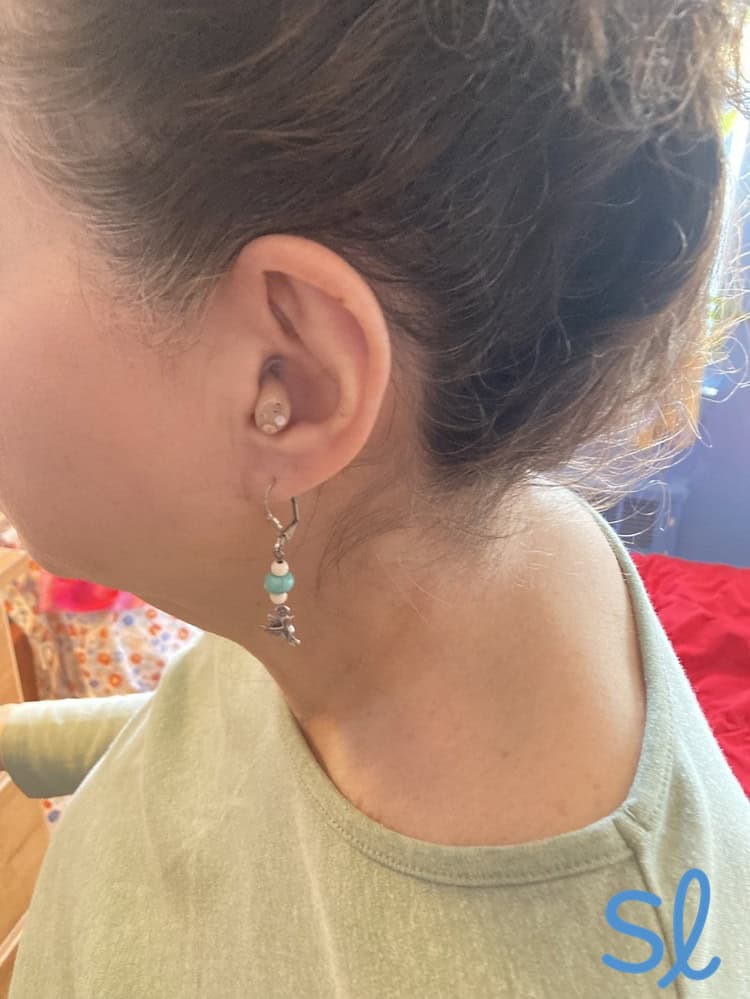
Wearing MDHearing s NEO XS PRO hearing aids
I have tinnitus in one ear, and occasionally, the hearing in that ear indicates mild hearing loss, but not always. I did notice that the hearing aids made everything around me sound crisper, both in my “bad” ear and in my good ear. The sound quality was also very natural, both indoors and outside.
I found the manual on/off volume and program control buttons on the hearing aids easy to use. The hearing aids stay put in your ears, even while you’re manipulating the buttons. If someone has hand dexterity issues, however, they will likely have difficulty with the on-ear controls. The removal string felt very sturdy. All in all, I find these hearing aids to be high quality. They provide fantastic sound clarity and are easy to use to insert and wear.
Did You Know? Age is the largest predictor of hearing loss. Approximately one in eight people in the United States aged 12 years or older has hearing loss in both ears. The bulk of that population is over 60 years old.2
The volume and program controls are easy to use. It just takes the push of a button on one hearing aid. To increase or decrease the volume, I pressed and released the button quickly. To change the program, I held the button down for three seconds and then released it. The number of beeps I heard indicated which program I was in. The choices are:
- Quiet: One beep
- Social: Two beeps
- Noisy: Three beeps
- Restaurant: Four beeps
Using the MD Hearing App for Programming
You can also program the NEO XS PRO devices through the MDHearing app. MDHearing’s older models don’t offer access to a mobile app, which is pretty unusual for the industry, so I appreciate this new mobile app.
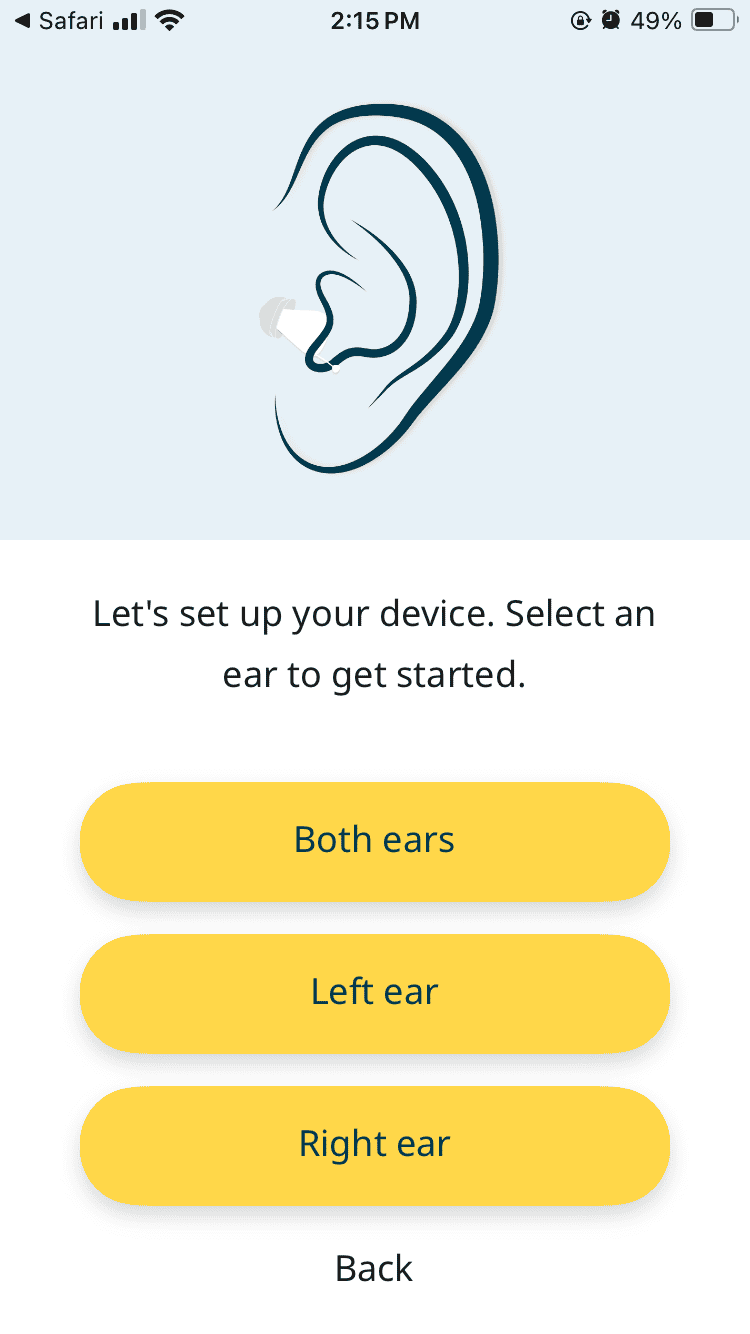
Using the MDHearing mobile app to set up my devices
The dedicated app manual included with the hearing aids gives you full instructions. Technology can be stressful for some seniors, so having things spelled out in writing can be very helpful. I downloaded the app for iOS. It included programming instructions for the four programs that are available for NEO XS PRO:
- Quiet
- Social
- Noisy
- Restaurant
I used the app to program the hearing aids individually for each ear. Programming the hearing aids is similar to taking an online hearing test. It took around 10 minutes. I found that the process was sophisticated and easy to do.
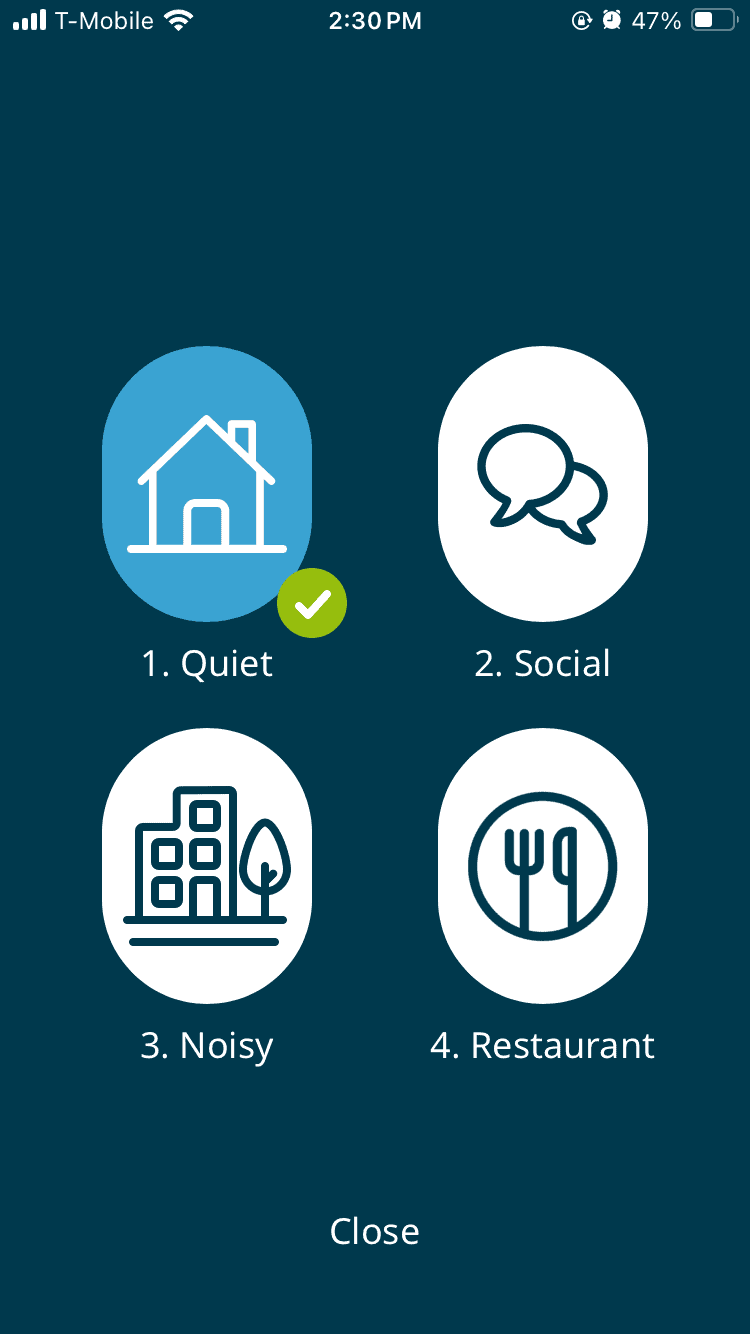
Customizing my MDHearing devices for different programs
In addition to the programs, the app has a volume control. I like that it also has a “Find my Device” feature, which I’m sure comes in handy if you lose your devices! You can use the app to adjust your hearing aids yourself, or you can reach out via the Support tab to have MDHearing’s hearing specialists adjust the sound settings for you.
The Details: MDHearing Models
Like other manufacturers, MDHearing offers multiple options at varying price levels. MDHearing also offers financing through a third party. Financing is common in hearing aid sales, but most financing options have very high interest rates for balances carried past the typical no-interest promotional period.

It’s important to note that all prices listed below are after discounts. MDHearing runs discounts year-round, bringing prices down to just a few hundred dollars per pair. The sales change throughout the year, so check out MDHearing’s website for all the details.
FYI: MDHearing sells QuietTV wireless headphones, perfect for TV lovers and movie buffs! The wireless TV headphones offer advanced voice-clarifying technology and adjustable volume for an enhanced TV-watching experience.
MDHearing AIR
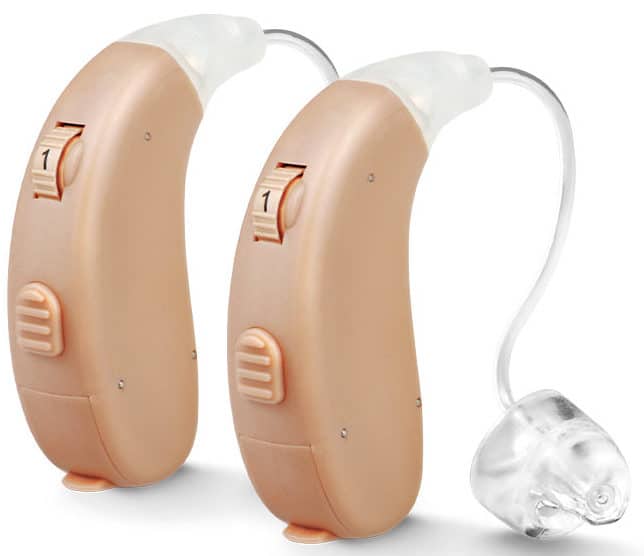
MDHearing AIR pair
The AIR is one of MDHearing’s most affordable models, priced at $297 per pair. The virtually invisible behind-the-ear (BTE) model offers advanced noise reduction. The rechargeable devices are best for those who need a simple device. Along with a portable charging case and a one-year warranty, you’ll get free lifetime support from the company’s team of audiologists. The long-term support is excellent, since some providers offer only short-term care after purchase. Jabra Enhance hearing aids, for example, come with only three years of follow-up care.
MDHearing NEO
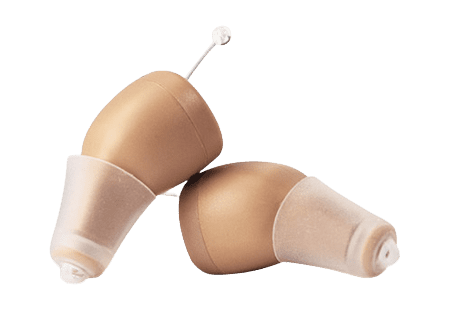
MDHearing NEO pair
MDHearing’s first in-the-ear (ITE) model is the NEO, which costs $297 per pair. The discreet in-the-ear style makes them nearly invisible. The NEO is also rechargeable and provides clear sound.
The NEO features advanced feedback-cancellation technology and noise reduction. You can hear better in noisy environments such as restaurants or busy streets. It also features manual volume control, which is very useful. This model is an excellent option for people wanting discreet hearing aids and those who wear glasses regularly.
MDHearing NEO XS
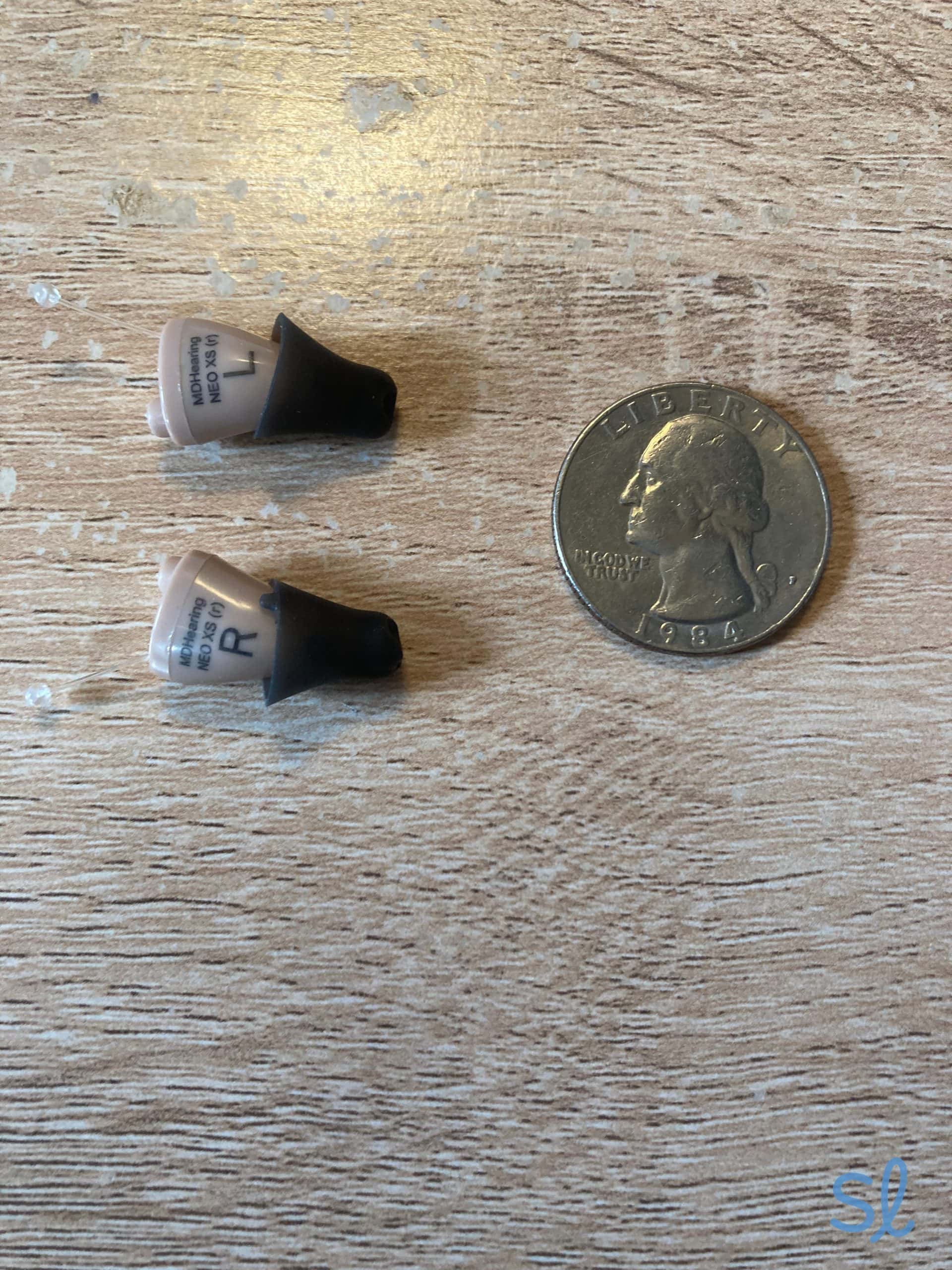
MDHearing NEO XS
MDHearing’s newest model, the NEO XS, is a smaller version of the NEO. Priced at $397 per pair, the ITE model is the company’s smallest rechargeable hearing aid yet. I appreciate the decrease in size, as some larger ITE hearing aids can be uncomfortable for smaller ears. For example, one of SeniorLiving.org’s writers tested Eargo hearing aids and found that the in-ear devices were painful for her ear shape. Smaller devices like the NEO XS help alleviate that discomfort.
It took me a little while to get used to wearing NEO XS. Once I did, I found them comfortable and effective. I like the portable charging case with magnetic holders and wax-guard cleaning tools. The removal string makes the hearing aids easy to insert or remove. It’s super flexible and easy to grasp. I was concerned that the string might break, so I played around with it a bit to see what would happen. I’m happy to report that it’s sturdier than it looks!
The NEO XS also features upgraded noise reduction and several environmental programs. Changing programs was simple and made a difference in sound quality in multiple environments. I live on a busy city street, and shifting the program to “noisy” enabled me to hear more sounds around me (including my neighbor’s barking dog). I recommend the NEO XS for seniors with smaller ears and individuals who prefer nearly invisible hearing aids.
NEO XS PRO
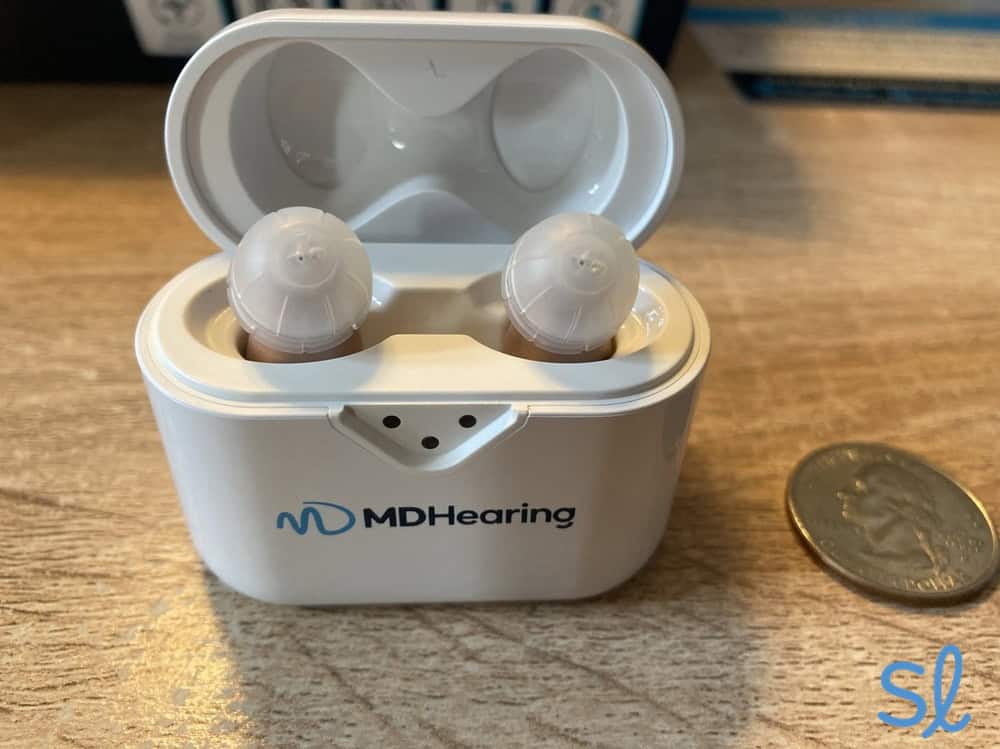
The NEO XS Pro from MDHearing
The NEO XS PRO is one of MDHearing’s most technologically advanced hearing aids to date. They’re also MDHearing’s most expensive offering, at $597 per pair. NEO XS PRO offers improved noise reduction and feedback cancellation, as well as four distinct listening environments. You can program your hearing aids on the devices themselves or through the app.
These hearing aids don’t have dual-directional microphone capability, but in my experience, they generate a comfortable listening experience during conversations in noisy environments. Overall, I’m a big fan of these hearing aids.
They’re smartphone-compatible and easy to program. When I tried them on for size, I found them to be very comfortable and discreet in my ears. They come with domes in multiple sizes, so you’re likely to find a fit that works for you. I like the tiny charging case and the ease of use these hearing aids provide. They also charge quickly and have a battery life of 18 hours.
MDHearing VOLT
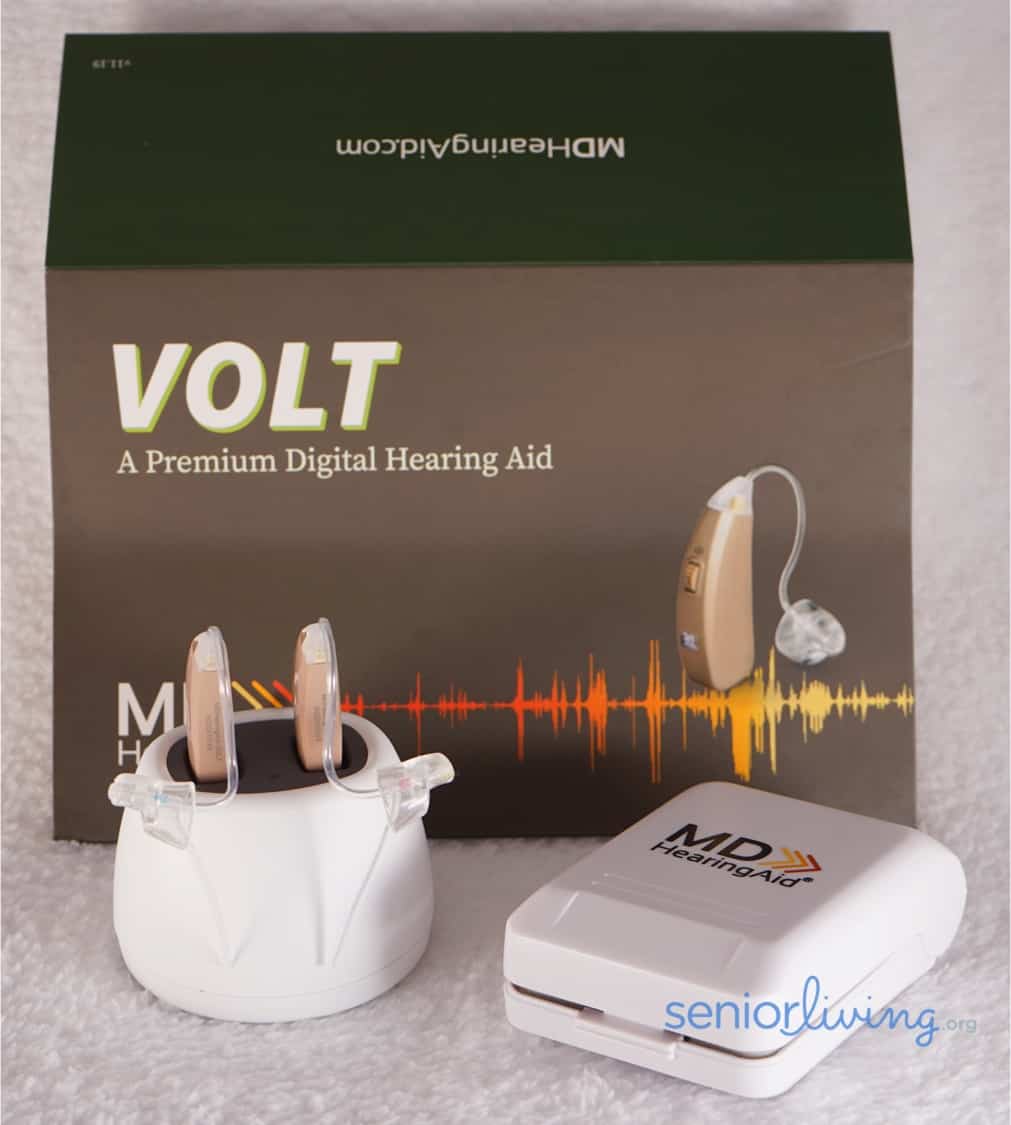
MDHearing VOLT packaging
The VOLT is one of MDHearing’s more advanced BTE models. At $397 per pair, VOLT is significantly less expensive than VOLT MAX 2, MDHearing’s most recent iteration of this BTE model. In my opinion, VOLT provides the same sound quality as VOLT MAX 2. The main difference between them is app compatibility. If being able to program your hearing aids through an app is essential to you, opt for the VOLT MAX 2, which costs $200 per pair more than the original VOLT.
This model features the same bells and whistles as MDHearing’s more advanced models, such as dual microphones, feedback cancellation, and smart noise reduction. Like all of MDHearing’s hearing aids, VOLT comes with lifetime support and a 100 percent money-back guarantee.
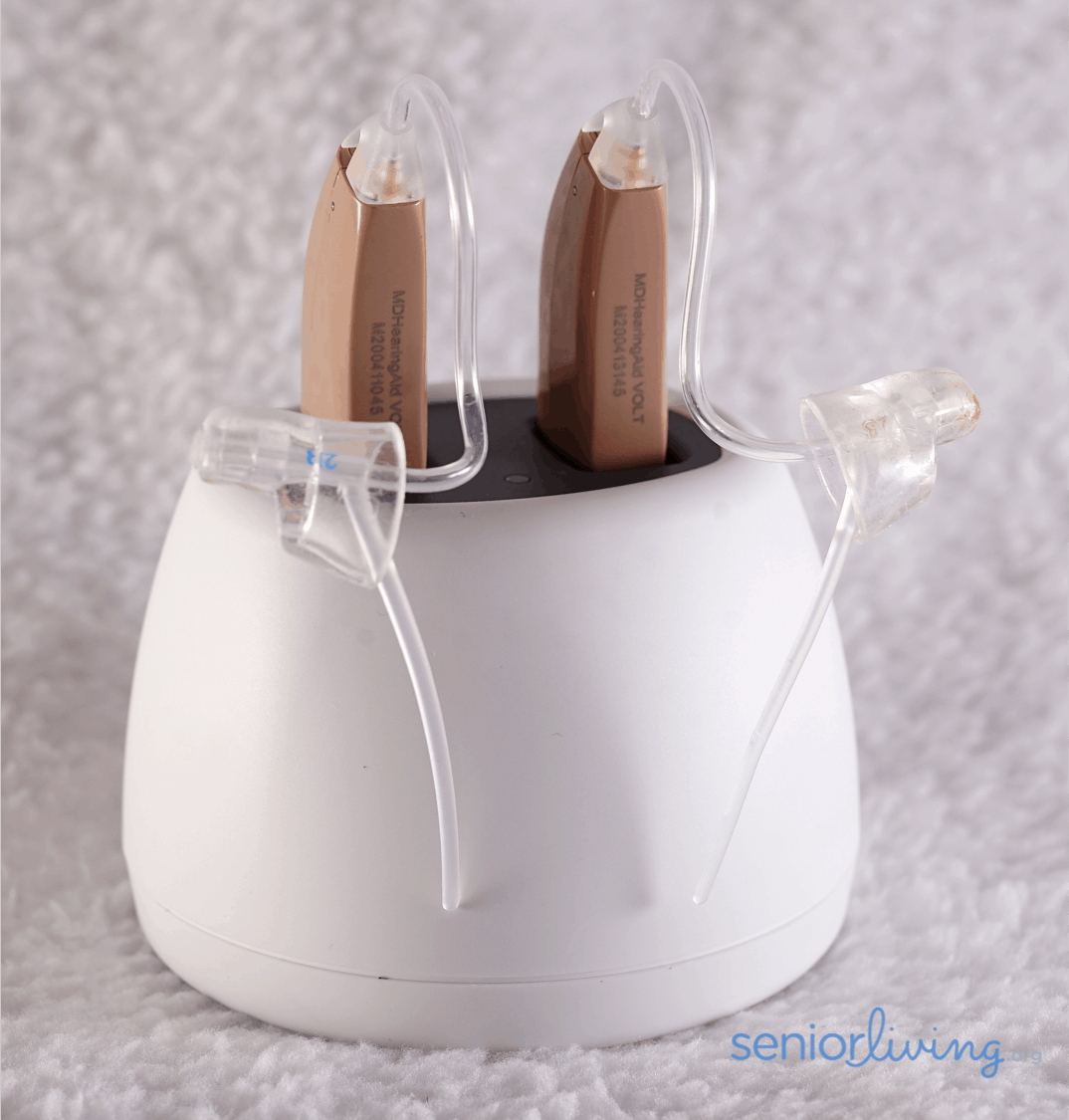
MDHearing VOLT in its charger
Check out our VOLT hearing aid video review for a closer look at this model!
VOLT MAX 2
The VOLT MAX 2 is MDHearing’s more advanced BTE model, costing $597 per pair. This model features dual microphones and smart noise reduction to help you focus on the sounds you want to hear versus distracting background noise. The VOLT MAX 2 also has the same advanced feedback cancellation and noise reduction as NEO XS PRO. These features prevent feedback and help you hear better in noisy environments.
The VOLT MAX 2 devices were well built, with an easy-to-use charger that fully charged the hearing aids in a few hours. My experience with the charger was spotty. I found the hearing aids difficult to get into the charger accurately enough to allow for smooth charging. I also noticed that the right and left hearing aids were not indicated. There are very faint red and blue markings on the tips designed to differentiate right from left, but they are challenging to see. It could be a real obstacle for seniors with vision loss. I wear glasses, but had a hard time finding the markings, even in excellent light.
The ear tips on VOLT MAX 2 are comfortable. I found ear tips in the package that allowed me to turn up the device about halfway without any feedback. If I had more severe hearing loss, I would need to use a different ear tip, which may have been tight. But generally, I was impressed.
I was similarly impressed that all of MDHearing’s devices are rechargeable, so you don’t have to remember to change your batteries regularly. If you have clumsy fingers like me, changing small batteries can be a real hassle. Like NEO XS PRO, VOLT MAX 2 can be programmed through the MDHearing app.
MDHearing Support
MDHearing won’t abandon you after your purchase. One of the VOLT MAX 2 hearing aids I received was defective, so I contacted the company. They sent me a new hearing aid, no questions asked, very quickly. I appreciate this fast and efficient support.
The company offers free access to its audiologists through the app and via email, or you can call a toll-free number for general customer service issues. The customer service department can assist with requests for replacement accessories like batteries, tubing, domes, storage cases, and cleaners. I found the individuals on the phone helpful and knowledgeable.
I had excellent experiences with MDHearing’s team, but the company could improve its follow-up care offerings. Jabra Enhance offers more in-depth follow-up care from its audiology team, although it’s available for only three years. It includes on-demand video calls, unlimited chat, remote adjustments, and individually programmed devices, all through a mobile app. You can read our Jabra Enhance review to learn more.
Compare MDHearing to Other Providers
Warranty
All MDHearing products include a 45-day free trial, as well as a parts-and-labor warranty. They also offer a one-year warranty. Additional coverage is available with the MDShield protection plan, which is typically one to two years.
One of the most notable limitations of typical OTC warranties is the lack of coverage for loss and damage, which is standard for most prescription hearing aid manufacturers. Even though the purchase price is low, a few losses can easily add up to the cost of a more advanced hearing aid offering loss-and-damage coverage. Individuals with memory loss, in my clinical experience, require loss-and-damage coverage. If you’re looking for an OTC brand with loss and damage protection, consider Jabra Enhance. Their Premium packages offer a three-year warranty with loss and damage protection.
MDHearing vs. the Competition
MDHearing is one of the most affordable OTC hearing aid providers on the market. However, their devices are simpler and less high-tech than options from more expensive brands like Eargo and Jabra Enhance. The choice will ultimately come down to your budget and desired features.
Here’s how MDHearing stacks up against other OTC brands:
| MDHearing | Eargo | Lexie | Jabra Enhance | |
|---|---|---|---|---|
| Price range per pair | $297-$597 | $799-$2,950 | $499-$999 | $995-$1,995 |
| Styles offered | ITE, BTE | ITE, earbud | RIC, BTE | RIE standard, micro, and miniature sizes |
| Bluetooth streaming | No | Earbud only | Some styles | Yes |
| App connectivity | Some styles | Yes | Yes | Yes |
Final Thoughts on MDHearing
MDHearing makes it easy to purchase hearing aids online for mild to moderate hearing loss. However, their technology is limited compared to some other brands. Technology has changed, but the human ear hasn’t. If your needs are simple and you’re looking for a budget-friendly alternative to high-end hearing aids, these may do the trick for you. Since most insurance plans in the U.S. don’t cover hearing aids, MDHearing provides access to many people with hearing loss who would otherwise be left out.


